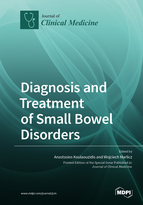Diagnosis and Treatment of Small Bowel Disorders
A special issue of Journal of Clinical Medicine (ISSN 2077-0383). This special issue belongs to the section "Gastroenterology & Hepatopancreatobiliary Medicine".
Deadline for manuscript submissions: closed (25 April 2019) | Viewed by 56586
Special Issue Editors
2. Centre for Clinical Implementation of Capsule Endoscopy (CICA), Store Adenomer Tidlige Cancere Centre (SATC-C), Svendborg, Denmark
Interests: capsule endoscopy; gastroenterology; collagenous colitis; microscopic colitis
Special Issues, Collections and Topics in MDPI journals
2. Endoklinika sp. z o.o., Szczecin, Poland
Interests: microbiome; colonoscopy; probiotics; colorectal cancer; gastric cancer; stem cells
Special Issues, Collections and Topics in MDPI journals
Special Issue Information
Dear Colleagues,
Over the last few decades, remarkable progress has been made in understanding the aetiology and pathophysiology of diseases and many new theories emphasize the importance of the small bowel ‘ecosystem’ in the pathogenesis of acute and chronic illness. Emerging factors such as microbiome, stem cells, innate intestinal immunity and the enteric nervous system along with mucosal and endothelial barriers have key role in the development of gastrointestinal and extra-intestinal diseases.
Therefore, the small intestine is considered key player in metabolic disease development, including diabetes mellitus, and other diet-related disorders such as celiac and non-celiac enteropathies. Another major field is drug metabolism and its interaction with microbiota. Moreover, the emergence of gut-brain, gut-liver and gut-blood barriers points toward the important role of small intestine in the pathogenesis of common disorders, such as liver disease, hypertension and neurodegenerative disease.
However, the small bowel remains an organ that is difficult to fully access and assess and accurate diagnosis often poses a clinical challenge. Eventually, the therapeutic potential remains untapped. Therefore, it is due time to direct our interest towards the small intestine and unravel the interplay between small-bowel and other gastrointestinal (GI) and non-GI related maladies.
Dr. Anastasios Koulaouzidis
Dr. Wojciech Marlicz
Guest Editors
Manuscript Submission Information
Manuscripts should be submitted online at www.mdpi.com by registering and logging in to this website. Once you are registered, click here to go to the submission form. Manuscripts can be submitted until the deadline. All submissions that pass pre-check are peer-reviewed. Accepted papers will be published continuously in the journal (as soon as accepted) and will be listed together on the special issue website. Research articles, review articles as well as short communications are invited. For planned papers, a title and short abstract (about 100 words) can be sent to the Editorial Office for announcement on this website.
Submitted manuscripts should not have been published previously, nor be under consideration for publication elsewhere (except conference proceedings papers). All manuscripts are thoroughly refereed through a single-blind peer-review process. A guide for authors and other relevant information for submission of manuscripts is available on the Instructions for Authors page. Journal of Clinical Medicine is an international peer-reviewed open access semimonthly journal published by MDPI.
Please visit the Instructions for Authors page before submitting a manuscript. The Article Processing Charge (APC) for publication in this open access journal is 2600 CHF (Swiss Francs). Submitted papers should be well formatted and use good English. Authors may use MDPI's English editing service prior to publication or during author revisions.
Keywords
- Small bowel
- Microbiome/Microbiota
- Coeliac and non-coeliac gluten sensitivity
- Drug-related enteropathies
- Capsule endoscopy (enteroscopy) & other non-imaging capsules
- Volatile Organic Compounds
- Confocal laser endomicroscopy
- Metagenomics & Metabolomics
- Gut barrier & Probiotics
- Enteric nervous system
- Gut-brain axis
- Gut-liver axis








